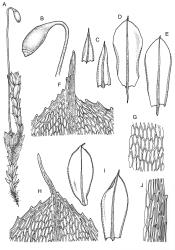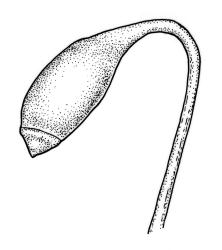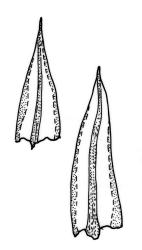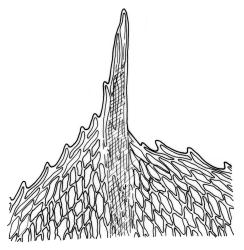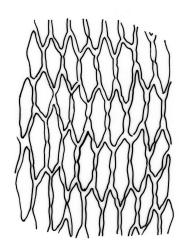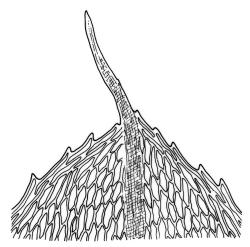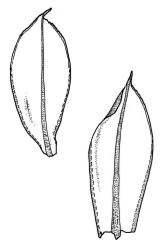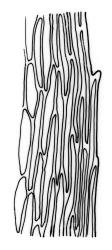- ≡ Bryum billardierei Schwägr., Sp. Musc. Frond. Suppl. 1(2), 115 (1816) – as billarderii
Plants bright- or yellow-green, weakly lustrous, not or weakly comose, forming turves. Stems red-brown, to c. 45 mm, in cross-section as per genus. Leaves ± uniformly distributed, erect-spreading or spreading when moist, much altered and often twisted around the leaf axis when dry, obovate, recurved below, abruptly tapered to narrowly-triangular and weakly reflexed cusp, 2.5–3.5 mm (including cusp), c. 2–4:1, moderately concave, lacking secondary pigmentation, sharply serrate in upper ⅓ or more by projecting cells ends, weakly bordered, not decurrent; upper laminal cells hexagonal to ± rhombic, firm-walled and porose, c. 45–75 × c. 25 µm and 3–4:1, in lower leaf becoming longer and more oblong, marginal cells linear, thicker-walled, and paler to form a weak border (commonly of 4–5 cells at widest part of leaf, fading to 1–2 cells at base of apical cusp); basal cells not differentiated. Costa pale brown throughout, excurrent to form a short (usually c. 120–200 µm) cusp. Tubers not seen in N.Z. material.
Dioicous. Perichaetia terminal, enclosing a single fruit. Perigonia terminal. Setae c. 20–35 mm, red, cygneous just below capsule, not hooked; capsules pendent, oblong-cylindric, curved in the neck and slightly curved or nearly straight above, (2–)3–3.5 mm; operculum mammillate, scarcely apiculate. Exostome teeth yellow-brown; endostome detail poorly seen in N.Z. material, with weakly appendiculate cilia. Spores 11–18 µm diam., finely papillose.
Schwägrichen 1816, pl. 76 (as Bryum billarderii); Spence & Ramsay 2006 fig. 46, j–s (as R. billarderi).
There is type material of Bryum billardierei in the Hedwig-Schwägrichen herbarium. Its examination confirms the concept of R. billardierei as having single, pendent and relatively short (c. 2–3.5 mm) capsules, moderately developed comae, short (2.5–3.5 mm, including the cusp) obovate leaves with ill-defined borders that narrow to only 1–2 cells wide at the leaf apex, and a narrowly-triangular and weakly reflexed cusp. Schwägrichen's (1816, pl. 76) illustration of Bryum billardierei is accurate in regard to leaf form and distribution and capsule form and number. The five plants comprising the holotype are comose, and one of the plants has subperichaetial innovations that overtop the coma.
The list of localities given by Bruch & Schimper for Bryum billardierei in Bryologia Europaea (Bruch et al. 1836–1846, p. 58) indicates B. billardierei has a southern European distribution, but beyond this gives no hint as to the provenance of the type collection. Prior to his collections in Tasmania and mainland Australia, de Labillardière travelled and collected extensively in Cyprus, Syria, and Lebanon in the years 1787–1788 (Duyker 2003). It is likely that the type of B. billardierei was collected there. In an appendix, however, Duyker (2003, p. 320) lists Bryum billardierei (as "billardieri") among several mostly Australasian plant species named in homage to de Labillardière. Ochi (1994), in his treatment of Bryum for the Moss Flora of Mexico, did not discuss the location of "Novo Belgio". Ochi’s (1994, fig. 366) illustration shows a plant somewhat more comose than N.Z. material and with abundant filiform axillary gemmae. In other respects, plants he described accord well with N.Z. material. The provenance of Schwägrichen’s type specimen, collected by de Labillardière, is an intriguing problem, but its resolution is beyond the scope of this Flora.
SI: Nelson (Travers R.), Otago, Southland; St; Sol.
Anomalous? Tasmania*, mainland Australia*. The wider distribution of this species is very unclear and depends on taxonomic interpretation. Spence & Ramsay (2006) considered it to be "a circum-temperate to subtropical species of the Southern Hemisphere, in Africa, Australasia, Malesia, Oceania, New Zealand, and Macquarie Is." and to be widely distributed in all Australian states and territories, except the Northern Territory. Ochi (1994) presented a very different distribution that included many northern hemisphere localities.
On rock or soil; often on sand in coastal situations. Ranging from near sea level to c. 400 m.
This species remains poorly understood in N.Z. and its status here is admittedly uncertain. Most of the N.Z. material referred here to R. billardierei is sterile, and from Otago L.D. southwards. A small number of additional sterile collections from Westland L.D. and various North I. localities approach R. billardierei but in my opinion cannot be placed here with confidence. The distinction between this species and the variable and much more common R. subtomentosum is not clear-cut. It is possible that some material tentatively referred here may be depauperate material of the latter species. It is best to continue to recognise this species as part of the N.Z. flora until its relationship to R. subtomentosum is better understood. However, since conflicting opinions concerning the status of B. billardierei and its allies have been published, clarity will be difficult to achieve.
Material collected at Horseshoe Bay, Stewart I. (W. Bell s.n., CHR 517730) agrees with Schwägrichen's type in all significant morphological features. Material collected at Flagstaff, Otago L.D. (D. Martin, 1879, CHR 517403) also agrees well with the type (albeit with capsule length at the shorter end of the range observed in the type).
Spence & Ramsay’s (2006) placement of Bryum leptothecium Taylor in the synonymy of B. billardierei is rejected here. They did not examine the type and may simply be following Mohamed’s (1979) earlier treatment of this Norfolk I. taxon. Taylor’s type is referable to R. subtomentosum.
Neither Ochi (1970, p. 55–59), Mohamed (1979, p. 401–412), Spence (1996, p. 223), nor Spence & Ramsay (2006, p. 333) saw type material of Bryum billardierei Schwägr. Schwägrichen’s protologue states that the type was "Legit in Novo Belgio Billardière, australium terrarium investigator celeberrimus." The interpretation that "Novo Belgio" refers to Tasmania (Ochi 1970, p. 59), which is often repeated in the Australasian literature (e.g., Sainsbury 1955, p. 279), seems to have originated with J.H. Willis. Willis’ interpretation was unfounded. The geographic identity of "Novo Belgio" is unknown to me and to several Austalasian colleagues (J. Beever, L. Cave, and P. Milne, all pers. comm., Oct. 2014) and its identification is crucial for the correct application of the name B. billardierei Schwägr.




